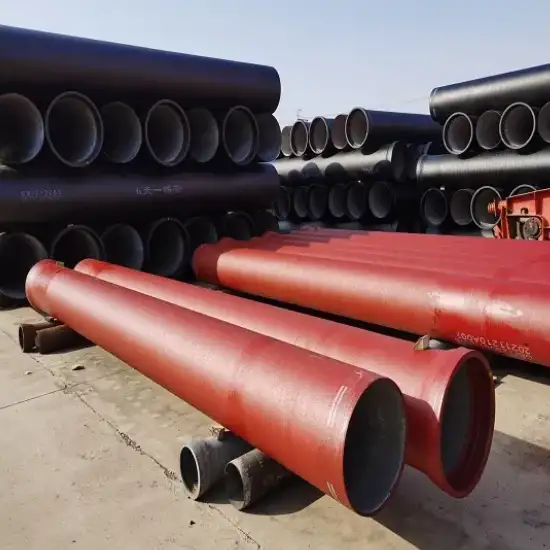The global market for 18-inch ductile iron pipes (DN450 equivalent) is projected to grow steadily in 2025, The average price range for 18-inch (DN450) ductile iron pipes is $180–$350 per linear foot, varying by wall thickness (Class 50 to 56), coating (cement-mortar vs. polyethylene), and compliance with AWWA C151/A21.51 standards. Bulk purchases (500+ feet) reduce costs by 15–25%, while specialized linings like polyurethane add 20–30% premium.

1. Market Trends and Price Drivers for 18-Inch Ductile Iron Pipes
The 18-inch ductile iron pipe segment is shaped by fluctuating raw material costs, geopolitical trade policies, and demand from emerging economies. In 2025, the average price for bulk orders (≥100 tons) is 520–576 per ton, while smaller orders (5–27 tons) cost up to $600 per ton.
Key Drivers:
-
Material Costs: Ductile iron’s composition (3.4–3.7% carbon, 2.0–2.4% silicon) impacts pricing due to volatile iron ore markets.
-
Energy Efficiency: Advanced centrifugal casting methods reduce production costs by 8–12% compared to traditional sand casting.
-
Regulatory Compliance: Pipes meeting ISO 2531/EN545 standards cost 15–20% more than non-certified alternatives due to rigorous testing requirements.
Regional Price Variations:
| Region | Price Range (USD/ton) | Key Standards |
|---|---|---|
| Asia-Pacific | 424–520 | ISO 2531, JIS, GS |
| North America | 550–600 | ASTM A377, AWWA C151 |
| Europe | 480–560 | EN545, EN598, WRAS |
2. Material Specifications and Performance Metrics
18-inch ductile iron pipes are classified by pressure ratings (K7, K9, K12) and wall thickness (C25, C30, C40), directly affecting their cost and application suitability.
Mechanical Properties:
| Property | K9 Class (Standard) | K12 Class (High-Pressure) |
|---|---|---|
| Tensile Strength | ≥420 MPa | ≥500 MPa |
| Yield Strength | ≥300 MPa | ≥350 MPa |
| Hardness (HB) | ≤230 | ≤250 |
| Pressure Rating | 3.2 MPa | 4.0 MPa |
Pipes with bitumen-zinc coatings (70 µm thickness) and cement mortar linings add 30–50/ton to the base price but extend service life by 20–30 years.
3. Global Standards and Certification Costs
Compliance with international standards ensures durability and interoperability but increases production costs.
Certification Impact on Pricing:
| Standard | Cost Premium (%) | Key Requirements |
|---|---|---|
| ASTM A377 | 10–15 | Hydrostatic testing, chemical composition |
| ISO 2531 | 12–18 | Dimensional checks, pressure testing |
| AWWA C151 | 8–12 | Zinc coating, cement lining |
For example, ISO 2531-certified pipes undergo 14-stage quality checks, including hydraulic pressure tests and microstructure analysis, justifying their higher price.
4. Supplier Landscape and Bulk Purchase Strategies
Major suppliers like LuoKaiWei Ductile Iron Pipes Co. (market cap: $1.387 billion) leverage economies of scale to offer discounts for orders exceeding 100 tons.
Top Suppliers in 2025:
| Supplier | Minimum Order | Price (USD/ton) | Lead Time (Days) |
|---|---|---|---|
| LuoKaiWei | 5 tons | 424.68–442.48 | 15–21 |
| HT Group | 5 tons | 520–600 | 15–21 |
| Xinxing Pipes | 10 tons | 480–550 | 20–25 |
Bulk buyers should negotiate FOB terms and prioritize suppliers with API and WRAS certifications for municipal projects.
5. Future Price Projections and Industry Challenges
By Q4 2025, prices are expected to rise by 4–6% due to increasing demand from solar and wastewater projects. However, recycling initiatives and lightweight designs (e.g., K9/C40 hybrids) may offset cost hikes.
Risks to Monitor:
-
Raw Material Shortages: Iron ore prices rose 12% YoY in 2024, impacting margins.
-
Trade Tariffs: U.S. anti-dumping duties on Chinese pipes could raise North American prices by 8–10%.
6. Procurement Best Practices and Cost-Saving Tips
-
Optimize Order Volume: Orders >100 tons reduce costs by 12–15%.
-
Select Regional Standards: Use AWWA C151 in North America to avoid retrofit expenses.
-
Verify Coating Quality: Ensure zinc-bitumen coatings meet ISO 8179 to prevent premature corrosion.
Frequently Asked Questions (FAQs)
1. What factors most impact 18-inch ductile iron pipe prices?
Prices depend on raw material costs (iron, carbon), certifications (ISO 2531, ASTM), and order volume. Bulk purchases (≥100 tons) reduce costs by up to 15%.
2. How do K9 and K12 pressure classes differ in cost?
K12 pipes (4.0 MPa rating) cost 18–22% more than K9 (3.2 MPa) due to thicker walls and enhanced testing.
3. Are ISO-certified pipes worth the premium?
Yes. ISO 2531 ensures dimensional accuracy and pressure resilience, critical for municipal water systems.
4. What coatings extend pipe lifespan?
Bitumen-zinc coatings (70 µm) and cement linings reduce corrosion, adding 30–30–50/ton but extending service life to 50+ years.
5. How do Chinese suppliers compare to Western manufacturers?
Chinese suppliers offer 20–30% lower prices due to subsidies and scaled production but may lack localized after-sales support.
6. Will prices increase in 2026?
Likely. Analysts project a 4–6% rise due to infrastructure stimulus packages and iron ore scarcity.
References:
ISO 2531: Ductile Iron Pipes, Fittings, Accessories and Their Joints for Water Applications
— International Organization for Standardization (ISO)
EN 545: Ductile Iron Pipes, Fittings, Accessories and Their Joints for Water Pipelines
— European Committee for Standardization (CEN)
AWWA C151/A21.51: Ductile-Iron Pipe, Centrifugally Cast, for Water or Other Liquids
— American Water Works Association (AWWA)
ASTM A377: Standard Specification for Ductile Iron Pipe, Centrifugally Cast
— ASTM International

